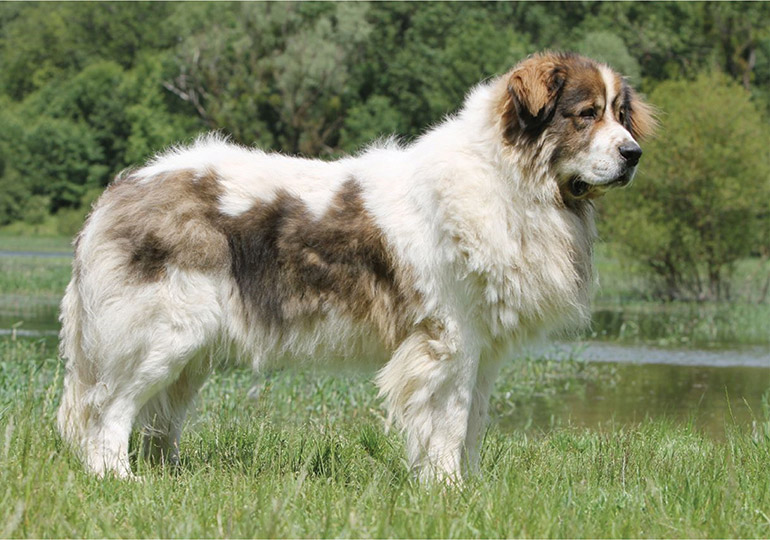Breeds
Pyrenean Mastiff

GROUP 6 - UTILITY
History
For a long time the Pyrenean Mastiff accompanied the herds of sheep in its migratory paths from the Aragonese and Navarrese Pyrenees until Maestrazgo. Its main function was to guard and protect the herds and its masters from the attacks of wolves, bears and thieves. During the 20th century, especially after the Spanish Civil War, due to economic difficulties, the mastiff went into decline as it was very expensive to keep a dog of its size. In the 1970s a group of fans started a job of recovery of the breed through the few specimens that were in the countryside and still had typical features of the ancient mastiff. It has been documented since 1977 as a modern purebred breed by the Club del Mastín del Pirineo de España in Spain. (1)
The mountain dog breed is now being taken from its native region and promoted as a pet in other countries like USA by the Pyrenean Mastiff Club of America. (2)
It was recognised by the Fédération Cynologique Internationale in 1982.
Appearance
That of a very large dog, above average size and of medium proportions. Harmonious, emphatically strong and muscular. Firm bone structure. Coat not exaggerated in length. In spite of his size, must not give the impression of being heavy or sluggish.
IMPORTANT PROPORTIONS : Within medium proportions.
· Well balanced and harmonious all over. The length of the body measures barely more than the height at withers.
· Length of skull in relation to bridge of nose = 5 : 4.
· Breadth of skull : Equal to or slightly larger than length.
· Relationship of height at withers to girth of chest is approximately 7 : 10.
Hair is dense, thick and of moderate length. The ideal medium length, measured on middle section of topline, should be 6 to 9 cm. The coat is longer on the shoulders, neck, under belly, at the back of legs as well as on the tail. On the plume, the texture is not as bristly as elsewhere on the body. The coat should bristly, not woolly in texture.
Basic colour is white, always with a well defined mask. Sometimes there are irregularly distributed distinctly outlined patches of the same colour as the mask. Tricolour or pure white dogs are undesirable. Ears always spotted. Tip of tail and lower parts of legs are always white. Mask should be clearly defined. It is an advantage if the outline of the patches is clear cut. At the roots, the coat should be as light as possible, ideally really white. The most desired colours are, in order of reference, pure white (snow-white), patches medium grey, intensive golden yellow, brown, black, greysilver, light beige, sandy or marbled. Undesirable are red patches and yellowish-white basic colour. (3)
Temperament & Suitability
Friendly towards humans, calm, noble and very intelligent, at the same time courageous and proud towards strangers from whom he never backs away. In his behaviour towards other dogs, he is good natured and aware of his superior strength. Occasionally, he will fight with great skill, an atavistic quality which goes back to hundreds of years of fighting wolves. His dark bark comes from deep within his chest. His expression is alert. (3)
This strong, rustic breed is self-reliant and calm. It is even-tempered and docile at home and is protective with children. It is gentle with other dogs as well as other pets and people it knows. However, if challenged, the Pyrenean Mastiff will not hesitate to defend its family or itself from a perceived threat. Although it is gentle and kind with a loving temperament, it takes its work seriously and needs a strong, experienced leader. Certainly this large breed should be socialised from puppyhood to encourage confidence, but it will always be in its nature to remain suspicious of strangers. (4)
The Pyrenean Mastiff should be trained with reward-based, positive lessons from as early an age as possible. This teaches it to pay attention to people. It is generally an independent-minded dog, and may not respect the owner if the owner is too passive. (4)
The Pyrenean Mastiff does not require a great deal of exercise, but it will become bored and restless without a sufficient amount. Several daily walks will give it the opportunity it needs to check its surroundings and get exercise. Outings are also a great way to socialize the Pyrenean Mastiff, who becomes gentler and more trusting with every friend it makes along the way. (4)
The Pyrenean Mastiff's longish coat needs regular brushing and combing. It is a regular shedder, too, so the more frequently it is brushed, the less shedding there will be. Its ears should be kept clean and dry, as should the areas around its eyes. (4)
In Conclusion
Now you know a little about the Pyrenean Mastiff, you may have think that this is the dog for you. Before you make a decision, please make contact with the breed club or your State controlling body for purebred dogs. They will be able to give you information about available puppies and also suggest dog shows where you can see the breed and speak to breeders. In this way you will gain a better perspective of the Pg and its needs and whether this breed would suit your lifestyle.


